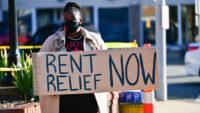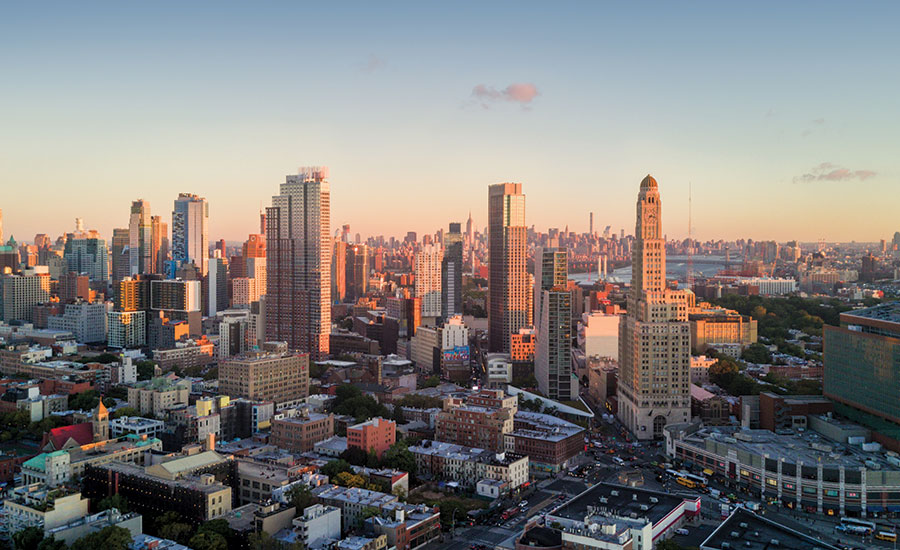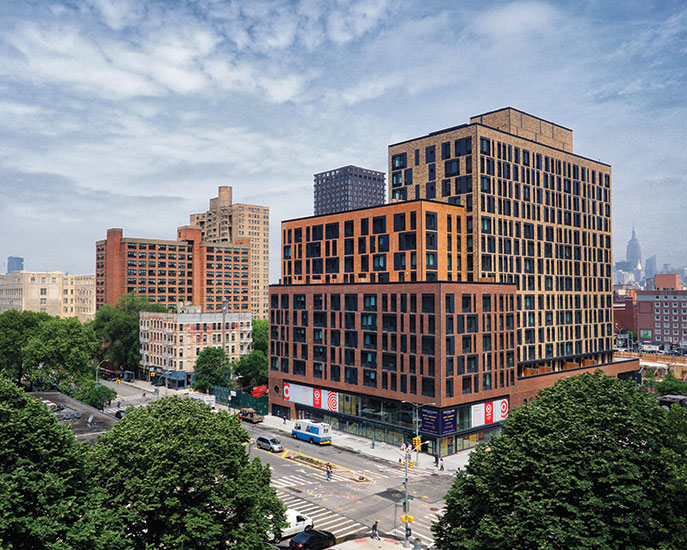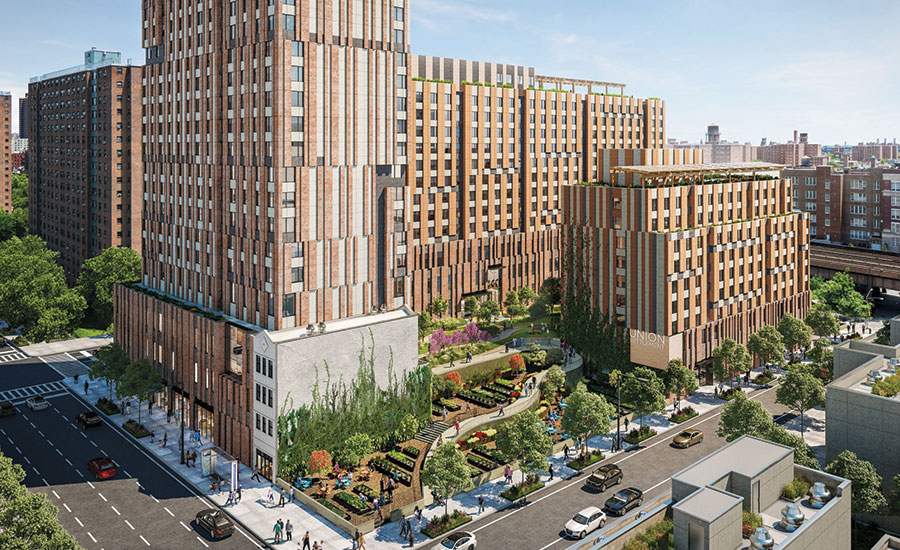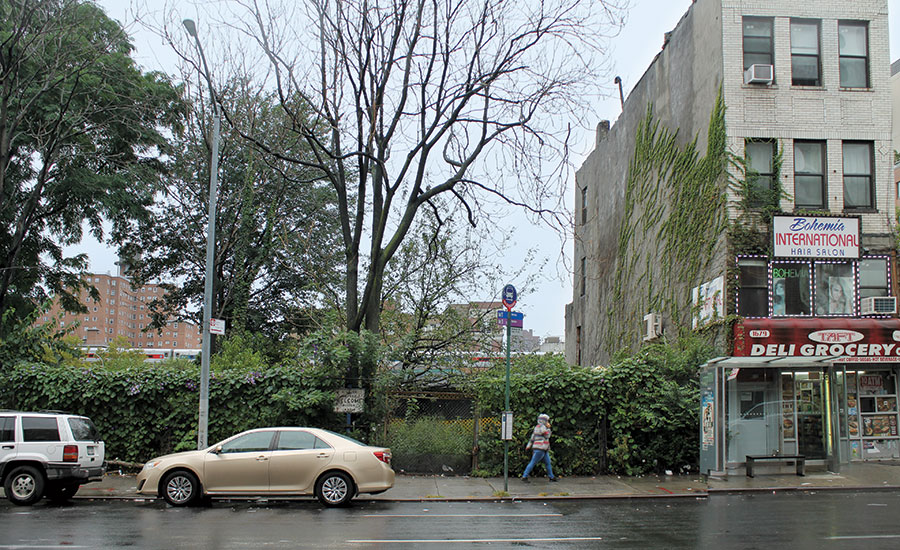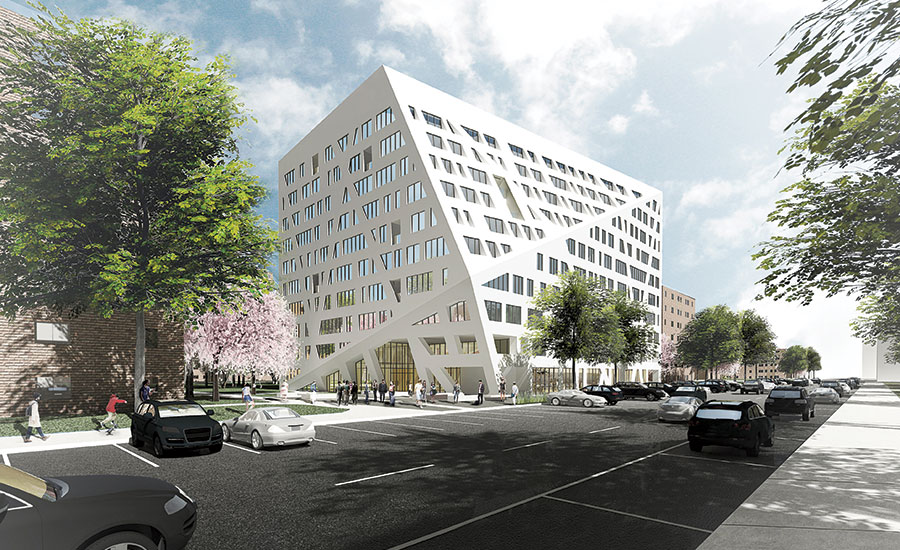The Housing Crisis in New York

A crop of new high-rise residential towers—including Steiner NYC’s 55-story Hub by Dattner Architects—is changing the landscape of Downtown Brooklyn and neighboring Fort Greene.
Photo © Pavel Bendov

The Rollins, by Beyer, Blinder, Belle, is a mixed-use, mixed-income residential and commercial building on Manhattan’s Lower East Side.
Photo © Joel Raskin

Handel Architects’ Sendero Verde will be built on a city-owned lot in East Harlem. Developers Jonathan Rose Companies, L+M Development Partners, and the Acacia Network promise that the three-building mixed-use complex will be 100 percent affordable.
Photo courtesy Handel Architects

Handel Architects’ Sendero Verde will be built on a city-owned lot in East Harlem. Developers Jonathan Rose Companies, L+M Development Partners, and the Acacia Network promise that the three-building mixed-use complex will be 100 percent affordable.
Photo © Architectural Record

The New York City Housing Authority plans to add affordable senior housing designed by Studio Libeskind to its Sumner Houses in Brooklyn’s Bedford-Stuyvesant neighborhood.
Photo © Studio Libeskind





The potential for what affordable housing could look like in New York is now just a field that spans nearly a square block in East Harlem.
But before the end of the year, ground will break on this city-owned land between 111th and 112th streets and Park and Madison avenues, making way for Sendero Verde, a $350 million mixed-use project that will deliver 655 units of affordable housing aimed at low- to middle-income residents. The three-building complex, designed by Handel Architects, will house a YMCA, a charter school, a grocery store, a health center, and a pizzeria. Community gardens and a central plaza designed by AECOM will fill the inner courtyard.
Sendero Verde brings the city’s vision of a robust housing program into focus. The plan, now called Housing New York 2.0, promises to preserve or build 300,000 units of affordable housing by 2026, at a cost of $83 billion. Despite this impressive goal, the most ambitious in the country, New York faces serious hurdles to meet its housing needs and keep the city livable for everyone from the poorest residents up to the middle class.
Roughly 77,000 New Yorkers are homeless, many of them families with children, according to a report from HUD. The city’s portfolio of public housing is aging and the stock of city-owned land is dwindling. At the same time, middle-class New Yorkers are migrating to outlying neighborhoods in search of cheaper rent, putting pressure on communities once considered immune from gentrification. Short-term rental services like Airbnb have cut into the housing supply, as tenants and landlords cash in on a hungry real-estate market. But, unlike other cities facing a relatively recent crisis, in New York, housing has always been a scarce resource.
“At every period, people have felt constrained by the physical barriers of the city. We’ve always built higher, built deeper, built denser. It’s why housing issues are so urgent here,” says Benjamin Dulchin, the executive director of the Association for Neighborhood and Housing Development, an advocacy group. “In some ways, since the founding of the city, we’ve expressed our class struggles through the struggle over space.”
New York City is the nation’s biggest public-housing landlord, with 400,000 tenants living in 325 developments controlled by the city’s housing authority, NYCHA. But the intense housing needs here reach back into history. The state enacted its first rent-regulation laws in 1920, in response to housing shortages and spiraling rents in the city. After World War II, a mix of private and public investment led to the rise of vast, subsidized middle-class housing developments like Stuyvesant Town-Peter Cooper Village in Manhattan and Co-op City in the Bronx. And in the 1980s, under Mayor Ed Koch, the city began investing billions of dollars of its own capital to turn abandoned properties into affordable housing units as a way to overcome blight. Although Koch’s plan was controversial at the time, it has since become doctrine.
Today, New York faces a different kind of housing crisis. The decline of the 1980s has been replaced with a boom. The population is growing and expected to reach 9 million by 2030. The city is constantly building, with roughly 25,000 new units constructed each year, transforming the skyline into one peppered with cranes and the sidewalks a maze of scaffolding and sheds.
Yet the demand for housing seems insatiable. As land values soar, landlords are pushing out longtime rent-stabilized tenants to make room for those able to pay more. Such evictions can lead to homelessness, putting more pressure on an overburdened shelter system. As New Yorkers move deeper into the outer boroughs looking for housing, neighborhoods that were once havens for the poor have become hot rental markets. A StreetEasy report found that although rents rose 31 percent citywide between 2010 and 2018, the spike was far greater in poorer neighborhoods. For example, the report found that rent in Midtown Manhattan remained relatively stable during that time, rising 16 percent, while in Prospect Lefferts Gardens, a Brooklyn neighborhood 45 minutes from Midtown, rent soared by 45 percent. All this comes at a time of growing economic inequality, with wages stagnating for many New Yorkers.
| Population: | Median Price of Home in 2012: | Median Price of Home in 2017: | Average Rent for 1-BR Apartment in 2012: | Average Rent for 1-BR Apartment in 2017: |
| 8.6 Million | $782,300* | $1,087,100* | $2,385** | $2,716** |
Source: *Metrostudy **Rainmaker Insights
Mayor Bill de Blasio, who was swept into office in 2013 on a platform decrying a “tale of two cities,” has been combating this crisis using a mantra laid out by Koch: build more units. But affordable-housing advocates worry that the centerpiece of his proposal—to rezone neighborhoods, like East Harlem, for larger development in exchange for mandatory affordable housing—could exacerbate the problem, rather than alleviate it. New market-rate development brings speculation and, inevitably, displacement.
The city sets the rent tenants pay for affordable units based on income, so that renters do not pay more than a third of their earnings on rent. In New York, the Area Median Income, a federal figure, is $93,900 a year for a family of three, meaning that such a family should spend no more than $2,608 a month on rent. The median rent for a two-bedroom apartment in Manhattan was $4,050 per month in July, according to a Douglas Elliman market report.
The city, private developers, and nonprofit organizations are exploring innovative solutions, like building new limited-equity co-op housing, where low or moderate-income New Yorkers buy apartments, some for less than $200,000, and can later resell them at restricted prices to other New Yorkers of moderate means; developing micro-units for young professionals; enacting new tenant protections like legal assistance for low-income tenants facing eviction; legalizing basement apartments; and building on the open space—such as parking lots—in existing public housing complexes.
“We’re going to need a lot more affordable housing,” says Jonathan F.P. Rose, the president of Jonathan Rose Companies, which is developing Sendero Verde with L+M Development Partners and the Acacia Network. Rose, whose company was a developer of Via Verde in the Bronx (record, July 2012), estimates that the city needs as many as 800,000 affordable units. “There is no one solution,” he says. “We need housing for a broad range of people, from the homeless to middle-income families.”
The apartments at Sendero Verde aim to serve a wide cross section of the population, from extremely low-income up to middle-income. The development will also include 79 units for seniors. Built to meet Passive House standards, the 750,000-square-foot complex will use roughly a third of the energy that a typical development of that size does.
The demand for affordable units is intense, with tens of thousands of people applying in lotteries for just a few hundred spots—as at the Rollins, a mixed-use building on the Lower East Side, where last year nearly 94,000 people applied for 104 affordable units. Designed to target a wide range of incomes, more than half of the units in the city’s plan are set aside for New Yorkers who earn no more than about $69,000 for a family of three. The initiative reaches down to the poorest residents, allocating 14.5 percent of the space for families earning no more than $43,000, and 10.5 percent for families earning up to $25,770. But it also targets moderate and middle-income New Yorkers, with 20 percent of units intended for those making as much as $142,000 a year, a figure that may seem startlingly high in lower-cost regions of the country, but points to just how far up the income ladder the housing shortage reaches in New York.
The city argues that the rent middle-income tenants pay helps subsidize the rents for the lowest-income brackets. But housing advocates look at those units and see space that could be dedicated to the neediest New Yorkers instead going to those with other options. Extremely low-income New Yorkers “can’t make their way in the private housing market,” says Thomas J. Waters, a housing-policy analyst at the Community Service Society, an advocacy group. “If you make $25,000 a year, you can afford $600 a month rent, and those apartments just don’t exist to match the numbers of people who need them.”
The city does not actually control its largest anchor of affordability—nearly half of its rentals, almost 1 million units, are stabilized under state laws, with rules adjusted by legislators 150 miles away in Albany. Legislative changes have loosened the protection on these apartments over the past 25 years, giving landlords the incentive to oust tenants so the apartments can be deregulated. Between 1994 and 2017, the city lost 284,301 units to deregulation—almost as many units as the goal is in the mayor’s current plan.
Holding onto a rent-stabilized apartment can feel like a blood sport, with landlords turning buildings into never-ending construction sites, offering tenants paltry sums of cash to leave, or bringing erroneous cases against them to get an eviction. Lisa Kirchner, a 65-year-old singer who has lived at the Windermere on the Upper West Side for 35 years, was once offered $20,000 to vacate her studio. Ms. Kirchner, who pays less than $1,000 a month, knew that any new apartment would cost significantly more, depleting her windfall in a matter of months. “Unless you leave with something you can invest,” like enough money for a down payment on an apartment, she says, “you’ve rendered yourself homeless.”
Mostly, the relationship with the landlord involves confrontations over repairs, noise, and disruptions. “You feel like there are buzzards circling—they are waiting for you to vacate, either by your own will or by the greater will,” Kirchner said. “It’s a very toxic environment.”
The city has stepped up efforts to protect tenants, offering tenants harassment assistance and, with the passage of a 2017 city law, guaranteeing low-income New Yorkers facing eviction a right to counsel. The city has also created a fund to locate and buy stabilized buildings to keep them out of the hands of investors eager for a quick profit, although it has not bought or designated any buildings as of yet.
Both the city and the state have cracked down on the use of online short-term rental platforms like Airbnb, arguing that such services contribute to rising rents by making neighborhoods more transient and taking potential rental apartments out of circulation. “The risk of running a high-cost city is that, very quickly, it could become solely a tourist destination,” says Matt Murphy, the deputy commissioner for policy and strategy at the city’s Department for Housing Preservation and Development.
However, rezoning gentrifying neighborhoods could undermine the city’s attempts to protect existing housing. Earlier this year, the City Council approved a plan to rezone a 92-block stretch of the southwest Bronx, setting the stage for this longtime low-income area, with low-rise commercial buildings housing auto-body shops, poultry slaughterhouses, and barbershops, to reemerge as one with high-rises and new retail.
Developers will be required to include permanently affordable units in any residential development in a rezoned area, a mandate known as inclusionary zoning. Housing advocates argue that rampant speculation sparked by rezoning will cause rents to rise and ultimately displace people, even if some units are set aside as affordable.
“If you create a situation where it makes sense for the developer to invest in that market-rate housing, that means people are willing to pay more for a fixed-up apartment across the street,” said the Community Service Society’s Waters. “That’s displacement pressure.”
But the city argues that displacement is happening whether or not a neighborhood is rezoned. By facing the issue head on, affordable housing is guaranteed at least a place at the table. “The rents are going up regardless of any rezoning, because the demand is incredibly strong,” says HPD’s Murphy.
In a city where two-thirds of its residents rent, home ownership gets less attention. The city has carved out an affordable co-op program in its plan that allows low- and moderate-income residents to buy an apartment in a limited-equity arrangement: a future buyer will need to meet income requirements. Ownership “allows people to stabilize over a long period of time,” says Christopher Illum, vice president of housing services for Habitat for Humanity New York City, which is developing, with Almat Group, Sydney House, a 56-unit affordable co-op of one-, two-, and three-bedroom apartments in the Bronx. “You have tenure and you don’t have to worry about deregulation.” Illum says that Habitat for Humanity buyers are typically households headed by single mothers. The minimum income needed for a Sidney House apartment will be between $41,000 and $72,000 a year, depending on the size of the unit. Sales will begin in early 2019, with prices ranging from $188,823 to $326,000.
The city is looking at open space in public-housing complexes controlled by NYCHA. Last spring, Studio Libeskind was tapped to build a 10-story building for seniors on the site of the Sumner Houses development in Bedford-Stuyvesant, Brooklyn. The white, geometric structure marks a departure from the utilitarian brick style typical of public housing. It will be Daniel Libeskind’s first residential development in the city.
Solving the housing puzzle means thinking differently. One option: encourage micro-units, apartments smaller than code previously allowed. Consider Caesura, a rental building with 123 mixed-income units in Fort Greene, Brooklyn, designed by Dattner Architects and Bernheimer Architecture and developed by Jonathan Rose Companies. A furnished market-rate studio, one of the 34 micro-units in the building, was listed for $2,955 a month for 300 square feet in August, or $118.20 per square foot—more than twice the Brooklyn average, which was $46.67 per square foot in July, according to Douglas Elliman.
Micro-units, in fact, are not cheap, and do nothing to provide for families. But with common amenities, like the lending library at Caesura, singles might be willing to forgo space for the chance to live in New York without a roommate.
The city has been encouraging developers to build tinier apartments, removing minimum-size requirements in 2016 for market rate apartments that were previously set at 400 square feet. The apartments must still have a kitchen and bathroom (where the costs are), and there are still hurdles for affordable-housing developers because various programs set their own limits on size.
In its quest for space, the city has been eyeing basement apartments. Although many subterranean quarters violate occupancy rules, they could ultimately deliver 40,000 more apartments. Last summer, legislation was introduced to the city council to legalize them, following a pilot program in East New York in Brooklyn, where landlords were encouraged to make safety improvements to the apartments while the city reviewed existing codes, like those regulating minimum ceiling height and window size.
Other overlooked corners to consider include slivers of public land too small for traditional building but large enough for a tiny house. The city plans to launch a design competition to build homes no larger than 400 square feet on some of these parcels. “We want to think about the future as a more efficient city,” says Murphy. “Can we do something smart and visionary that people will want to live in?”

